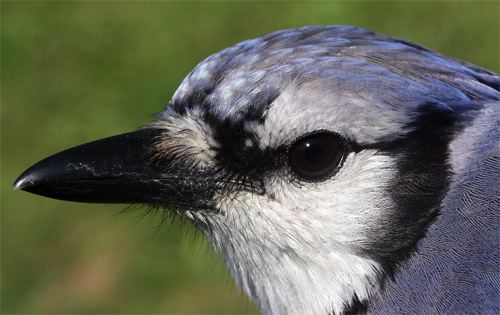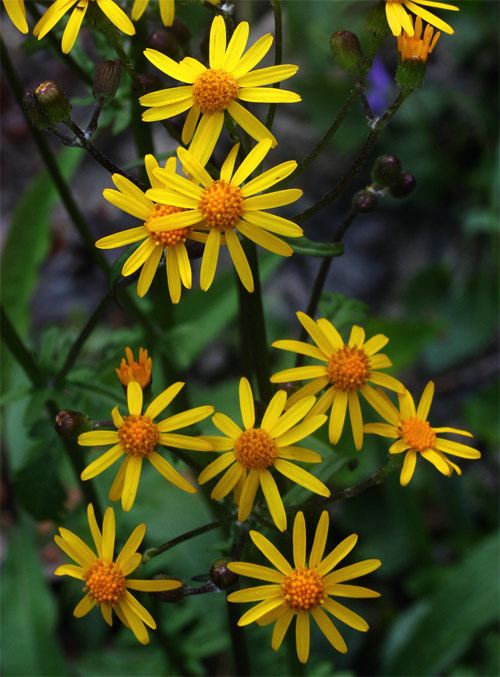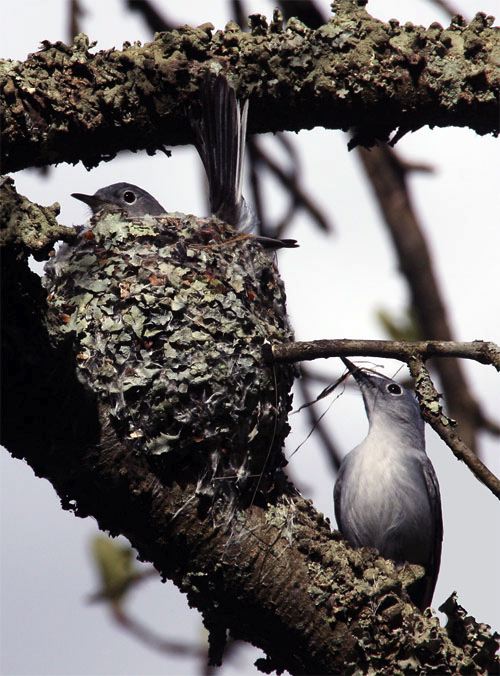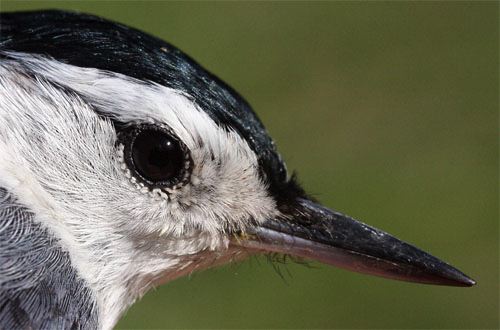|
|
|||
|
(Back to Preceding Week; on to Next Week) |
|
APPALACHIAN SPRING 2010 We've been fortunate every spring since 2003 to spend time in Fayette County, West Virginia, home of the New River Birding & Nature Festival. Lots of folks are familiar with New River Gorge, its dazzling single-span bridge, and its world-class whitewater rafting opportunities.
All text & photos © Hilton Pond Center
We arrived in West Virginia on 23 April at Opossum Creek Retreat, home base for the New River Birding & Nature Festival and a pleasant group of cabins in the woods. There we found Eastern Redbuds finishing up their spring floral display, with Flowering Dogwoods just coming into prime.
 An expected wave of migrant warblers and other songbirds hadn't yet begun although there were reports of Ruby-throated Hummingbirds visiting nearby feeders. Blue Jays (above) were particularly noticeable as their relatively quiet winter feeding assemblages of 20 or so birds were breaking up into rowdy ten-bird courtship flocks in which several males--likely first-time breeders--were trying to win the attention of two or three harried females. Green-up was in full swing, so we were eager to deploy our mist nets AND to explore the surrounding forest. An expected wave of migrant warblers and other songbirds hadn't yet begun although there were reports of Ruby-throated Hummingbirds visiting nearby feeders. Blue Jays (above) were particularly noticeable as their relatively quiet winter feeding assemblages of 20 or so birds were breaking up into rowdy ten-bird courtship flocks in which several males--likely first-time breeders--were trying to win the attention of two or three harried females. Green-up was in full swing, so we were eager to deploy our mist nets AND to explore the surrounding forest.
All text & photos © Hilton Pond Center Other than flowering trees, perhaps the most noticeable Fayette County blossoms the last week in April were those of Golden Ragwort, Packera aurea (above). These one-inch diameter composite flowers were quite common in open areas just off the rural highways. Like other members of the Sunflower Family (Asteraceae, AKA Compositae), one-foot-tall ragwort has two kinds of flowers--the fertile orange "disk flowers" that make seeds, plus infertile, bright yellow "ray flowers" that attract pollinators and that many folks incorrectly refer to as petals. There are many species of composites, but most yellow ones blossom in summer or fall rather than in spring like Golden Ragwort.
All text & photos © Hilton Pond Center Not far from the ragwort a sharp-eyed Elderhostel participant found another interesting plant growing in--of all places--a roadside ditch. Shaded by overhanging needles of an Eastern Hemlock, the plant's leaves were light green, leathery, elongate, and with prominent parallel veins--signs this was one of the terrestrial orchids. Unlike epiphytic orchids that cling to tree bark and rocky cliff faces throughout the tropics, North America's terrestrial orchids are rooted in the soil. Often overlooked and surprisingly abundant--there are 50-plus species in the southern Appalachians and a dozen or more in the Carolina Piedmont--terrestrial orchids can even be found growing in grassy lawns but are more often indicators of old-growth woodland and rich, undisturbed soil. The lilac-and-white variety (above) along the entrance road to Opossum Creek Retreat was a Showy Orchis, Galearis spectabilis, which occurs primarily in beech and maple woods under alkaline conditions.
All text & photos © Hilton Pond Center Back at the cabins at Opossum Creek Retreat we were pleased to see a familiar sight: An industrious pair of Blue-gray Gnatcatchers (above) building a nest about 30 feet up on a horizontal branch. We suspect this was the same twosome observed by attendees of the past several New River festivals. These two gnatcatchers know their spring task well: Gather spider webs and dried vegetation; weave together a four-inch tall structure; adorn it externally with a camouflaging layer of gray-green lichens; and line the whole thing with soft plant down. Unlike some bird species, both male and female work on nest construction, and both hop into the nest to help form the cup that eventually will hold four or five bluish eggs with reddish-brown spots. The pair may spend up to two weeks on perfecting the nest; once incubation begins, the potential parents swap off duties during the day. In the photo above, the male--identifiable by a dark streak above each eye--molds the cup while the female brings in fine threads of vegetative material. (Incidentally, the gnatcatcher's lichen-covered nest looks much like that of a Ruby-throated Hummingbird, but the hummer's is only an inch or two tall and two inches in diameter--roughly one-fourth the size.)
All text & photos © Hilton Pond Center In moist woods beyond the gnatcatcher nest we found a colony of plants with parasol-like leaves poking up from a forest floor still carpeted with last autumn's leaf drop. These were unmistakably Mayapples, Podophyllum peltatum, soaking up whatever sun filtered through the canopy and photosynthesizing enough energy to eventually produce small fruits that give rise to their name. Mature Mayapple leaves were a uniform rich green, while younger ones (above) were mottled. Before taking this photo, we'd never noticed how fuzzy the leaf margins are in Mayapple. It was tough running mist nets at New River Birding & Nature Festival this year. The first day it rained on and off, so we were forced to shut nets and reopen them several times. A wet bird in a net could die quickly from hypothermia as its feathers become matted and lose their insulating capabilities, and the bird's welfare is always the highest priority of any conscientious banding effort. The other two scheduled banding days also got off to slow starts because of unexpectedly cold weather. On 28 April the frost was so heavy it almost froze the nets shut--overnight temperatures had plummeted to the mid-20s--and 29 April was only a few degrees warmer. Again, for the sake of the birds we kept our nets closed until morning temps got up to about 45 degrees or so.
We had brought along a couple of traps we baited with cracked corn and sunflower seeds, so despite cold weather we were able to capture enough birds to provide an educational experience for anyone who cared to watch. In all we captured and banded a nice assortment of 24 birds of 14 species--including four of those recently arrived, fully gorgeted Ruby-throated Hummingbirds. Our three-day banding totals are listed in the table above. (In all, Festival observers tallied 145 species of resident and migrant birds seen and/or heard, including 28 Wood Warblers!)
All text & photos © Hilton Pond Center Although Festival participants were keenly interested in whatever species we caught and displayed, the bird that impressed us most was a White-breasted Nuthatch (above) that entered a trap on 28 April. We knew from his dark cap the nuthatch was a male--females tend to have paler, grayer heads--although we were perplexed when we noted the bird already carried a band. It wasn't the presence of the band that was surprising--we've been banding at Opossum Creek Retreat for so long we've often recaptured our own birds in later years. No, the curious thing was the nuthatch was banded on the RIGHT leg. We always band males of any species on the LEFT leg, so we knew this bird wasn't one of ours. Catching someone else's banded bird is always an exciting occurrence for a bander, but something seemed familiar about this particular nuthatch. We checked our records for birds banded or recaptured at Opossum Creek and realized we actually had handled this bird once before--two Festivals ago on 5 May 2008.
All text & photos © Hilton Pond Center That year we contacted the federal Bird Banding Laboratory (BBL)--clearing house for all banding in the U.S.--and learned the nuthatch had been caught first by Ron Canterbury, who also had done bird banding in early years of the New River Birding & Nature Festival. After we filed our recapture report in 2008, the BBL sent us a certificate (above) indicating Ron banded the nuthatch on 4 May 2005 at Opossum Creek. Since White-breasted Nuthatches are a non-migratory species, this individual almost certainly has been hanging around the retreat for quite a while; he's classified as an "after-fifth-year" bird, aged according to BBL protocols as at least five years, ten months. Most White-breasted Nuthatches die before they're a year old, so our recapture has a chance at the known record for his species: Nine years, ten months.
All text & photos © Hilton Pond Center This year, for the first time, some participants in the New River Birding & Nature FESTIVAL took field trips to the 1,000-acre Wolf Creek Park, home of the newly established New River Birding & Nature CENTER. We've worked with Fayette County government the past 20 months to develop a plan for this Nature Center--a focal point for an innovative mixed-use development that will include light industry, business, and residential components. A planned LEED-certified visitor center (above) with a hoped-for groundbreaking in 2012 will be the hub for an extensive trail system that already includes a 265' Wetlands Boardwalk (below) we designed and helped install last autumn.
All text & photos © Hilton Pond Center Eventually the boardwalk will be ten times longer, and perhaps 20 miles of nature trails will give folks who "live, work, learn, and play" at Wolf Creek Park access to varied habitats throughout the property. Only a third of the acreage will be developed, with the remainder devoted to "green space."
All text & photos © Hilton Pond Center As the Wolf Creek project unfolds, we're coordinating in-depth inventories of flora and fauna on the thousand acres, with several motives: 1) Knowing just what kinds of plants and animals actually exist at this early stage in the project; 2) Being able to advise exactly which habitats should be protected from disturbance and development; and, 3) Understanding the local environment so outdoor educators can explain how everything natural ties together at Wolf Creek Park. To this end we've designed checklists and are documenting photographically plants and animals we encounter on our monthly visits to the area. The remaining images in this photo essay all came from Wolf Creek Park, including the Sweet White Violet, Viola blanda (above). The lower petals have purplish veins and the flower stalks are reddish, while the leaves are almost circular. This species grows across the northestern third of North America, including the Carolinas.
All text & photos © Hilton Pond Center Several violets are difficult to identify--some botanists claim West Virginia hosts upwards of three dozen different species--but others are quite distinctive. The one just above with narrow, pointed foliage is Viola hastata, the Halberd-leaf Yellow Violet. Unlike many violets whose blossoms are low to the ground, this one has flowers and leaves atop a five-inch-tall stem. (A halberd, by the way, is a combination spear and battle-axe used in Europe in the 15th and 16th centuries.) This species can be found from New York south to Alabama and Florida, but in some locales it is quite rare.
All text & photos © Hilton Pond Center As we strolled one of the trails at Wolf Creek Park we came to a shallow puddle about four feet by eight feet--all that remains from nearly 100 inches of snow that fell on Fayette County in the "endless winter" of 2009-10. At several places in the pool we saw black masses that, upon closer inspection, turned out to be dense concentrations of inch-long tadpoles. These larval amphibians roiled the puddle's muddy bottom when we approached, clouding the water and making it difficult to get a clear photo; the one above is the best we could do. We weren't able to positively I.D. the species that produced these tadpoles but suspect Northern Leopard Frog, Rana pipiens. Identification of tadpoles often requires examination of mouthparts--or just waiting to see how metamorphosis turns out.
All text & photos © Hilton Pond Center On the partly shaded bank of a stream that feeds Wolf Creek Park's wetlands we found a nice bed of mosses in which were growing ferns and several wildflowers. The one above stood out from the rest because it was erect and bore 1.5-inch pale yellow blossoms that contrasted nicely with the dark green substrate. We identified it as Large-flowered Bellwort, Uvularia grandiflora, another wildflower with wide distribution--this time across the eastern and central U.S. and north into boreal eastern Canada. Even though this species may be relatively common throughout its range, it's important to know it grows along trails that will be used by the New River Birding & Nature Center and that it's just one of many native organisms--along with nest-building gnatcatchers, terrestrial orchids, and wriggling tadpoles--that can be seen in the Mountain State of West Virginia during Appalachian Spring. All text & photos © Hilton Pond Center POSTSCRIPT: One of our personal highlights at this year's New River Birding & Nature Festival was bumping into three attendees we already knew but hadn't expected: Terry & Jerry Williams of far-off Potola CA and Pat Barker from just down the pike in Charleston WV. All three are alumni of our midwinter Operation RubyThroat hummingbird expeditions to Costa Rica--the Williamses as wind-blown "Beta Niners" in 2009 and Pat this year as a "20-Tenner." The world of birds and birders is tightly intertwined.
|


 Those who also attend the Festival (warbler pinwheel logo at left) quickly learn why Bird Watcher's Digest calls it one of the top events of its kind in North America. Although the Festival takes us away from Hilton Pond Center for a whole week, we always enjoy our time in the Mountain State--where our primary role is to lecture and lead field trips and bird banding demonstrations for Festival participants and a concurrent Elderhostel session. During the week we also try to sneak in a little time for solitary meanderings through local woods, taking unhurried photos of an "Appalachian Spring" that comes a couple of weeks later than vernal activity in the Carolina Piedmont.
Those who also attend the Festival (warbler pinwheel logo at left) quickly learn why Bird Watcher's Digest calls it one of the top events of its kind in North America. Although the Festival takes us away from Hilton Pond Center for a whole week, we always enjoy our time in the Mountain State--where our primary role is to lecture and lead field trips and bird banding demonstrations for Festival participants and a concurrent Elderhostel session. During the week we also try to sneak in a little time for solitary meanderings through local woods, taking unhurried photos of an "Appalachian Spring" that comes a couple of weeks later than vernal activity in the Carolina Piedmont.











